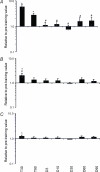The effects of heavy resistance training and detraining on satellite cells in human skeletal muscles
- PMID: 15218062
- PMCID: PMC1665027
- DOI: 10.1113/jphysiol.2004.065904
The effects of heavy resistance training and detraining on satellite cells in human skeletal muscles
Abstract
The aim of this study was to investigate the modulation of satellite cell content and myonuclear number following 30 and 90 days of resistance training and 3, 10, 30, 60 and 90 days of detraining. Muscle biopsies were obtained from the vastus lateralis of 15 young men (mean age: 24 years; range: 20-32 years). Satellite cells and myonuclei were studied on muscle cross-sections stained with a monoclonal antibody against CD56 and counterstained with Mayer's haematoxylin. Cell cycle markers CyclinD1 and p21 mRNA levels were determined by Northern blotting. Satellite cell content increased by 19% (P= 0.02) at 30 days and by 31% (P= 0.0003) at 90 days of training. Compared to pre-training values, the number of satellite cells remained significantly elevated at 3, 10 and 60 days but not at 90 days of detraining. The two cell cycle markers CyclinD1 and p21 mRNA significantly increased at 30 days of training. At 90 days of training, p21 was still elevated whereas CyclinD1 returned to pre-training values. In the detraining period, p21 and CyclinD1 levels were similar to the pre-training values. There were no significant alterations in the number of myonuclei following the training and the detraining periods. The fibre area controlled by each myonucleus gradually increased throughout the training period and returned to pre-training values during detraining. In conclusion, these results demonstrate the high plasticity of satellite cells in response to training and detraining stimuli and clearly show that moderate changes in the size of skeletal muscle fibres can be achieved without the addition of new myonuclei.
Figures







Similar articles
-
The effect of resistance training, detraining and retraining on muscle strength and power, myofibre size, satellite cells and myonuclei in older men.Exp Gerontol. 2020 May;133:110860. doi: 10.1016/j.exger.2020.110860. Epub 2020 Feb 1. Exp Gerontol. 2020. PMID: 32017951
-
Enhanced satellite cell proliferation with resistance training in elderly men and women.Scand J Med Sci Sports. 2007 Feb;17(1):34-42. doi: 10.1111/j.1600-0838.2006.00534.x. Scand J Med Sci Sports. 2007. PMID: 17305939
-
Assessment of satellite cell number and activity status in human skeletal muscle biopsies.Muscle Nerve. 2009 Sep;40(3):455-65. doi: 10.1002/mus.21369. Muscle Nerve. 2009. PMID: 19705426
-
The behaviour of satellite cells in response to exercise: what have we learned from human studies?Pflugers Arch. 2005 Nov;451(2):319-27. doi: 10.1007/s00424-005-1406-6. Epub 2005 Aug 10. Pflugers Arch. 2005. PMID: 16091958 Review.
-
The satellite cell as a companion in skeletal muscle plasticity: currency, conveyance, clue, connector and colander.J Exp Biol. 2006 Jun;209(Pt 12):2276-92. doi: 10.1242/jeb.02088. J Exp Biol. 2006. PMID: 16731804 Review.
Cited by
-
Comparison of muscle activity and tissue oxygenation during strength training protocols that differ by their organisation, rest interval between sets, and volume.Eur J Appl Physiol. 2016 Sep;116(9):1795-806. doi: 10.1007/s00421-016-3433-8. Epub 2016 Jul 20. Eur J Appl Physiol. 2016. PMID: 27439989
-
Neither myonuclear accretion nor a myonuclear domain size ceiling is a feature of the attenuated hypertrophic potential of aged human skeletal muscle.Geroscience. 2023 Feb;45(1):451-462. doi: 10.1007/s11357-022-00651-y. Epub 2022 Sep 9. Geroscience. 2023. PMID: 36083436 Free PMC article.
-
The effects of whey protein on myostatin and cell cycle-related gene expression responses to a single heavy resistance exercise bout in trained older men.Eur J Appl Physiol. 2008 Jan;102(2):205-13. doi: 10.1007/s00421-007-0579-4. Epub 2007 Oct 9. Eur J Appl Physiol. 2008. PMID: 17924133
-
Effects of photobiomodulation therapy combined to static magnetic field in strength training and detraining in humans: protocol for a randomised placebo-controlled trial.BMJ Open. 2019 Oct 28;9(10):e030194. doi: 10.1136/bmjopen-2019-030194. BMJ Open. 2019. PMID: 31662370 Free PMC article.
-
Impact of viral-mediated IGF-I gene transfer on skeletal muscle following cast immobilization.Am J Physiol Endocrinol Metab. 2010 Nov;299(5):E730-40. doi: 10.1152/ajpendo.00230.2010. Epub 2010 Aug 24. Am J Physiol Endocrinol Metab. 2010. PMID: 20739512 Free PMC article.
References
-
- Adams GR. Role of insulin-like growth factor-I in the regulation of skeletal muscle adaptation to increased loading. In: Holloszy JO, editor. Exercise and Sport Sciences Reviews. Baltimore: Williams & Wilkins; 1998. - PubMed
-
- Adams GR, Haddad F, Baldwin KM. Time course of changes in markers of myogenesis in overloaded rat skeletal muscles. J Appl Physiol. 1999;87:1705–1712. - PubMed
-
- Allen DL, Monke SR, Talmadge RJ, Roy RR, Edgerton VR. Plasticity of myonuclear number in hypertrophied and atrophied mammalian skeletal muscle fibers. J Appl Physiol. 1995;78:1969–1976. - PubMed
-
- Allen DL, Roy RR, Edgerton VR. Myonuclear domains in muscle adaptation and disease. Muscle Nerve. 1999;22:1350–1360. - PubMed
Publication types
MeSH terms
LinkOut - more resources
Full Text Sources
Research Materials

